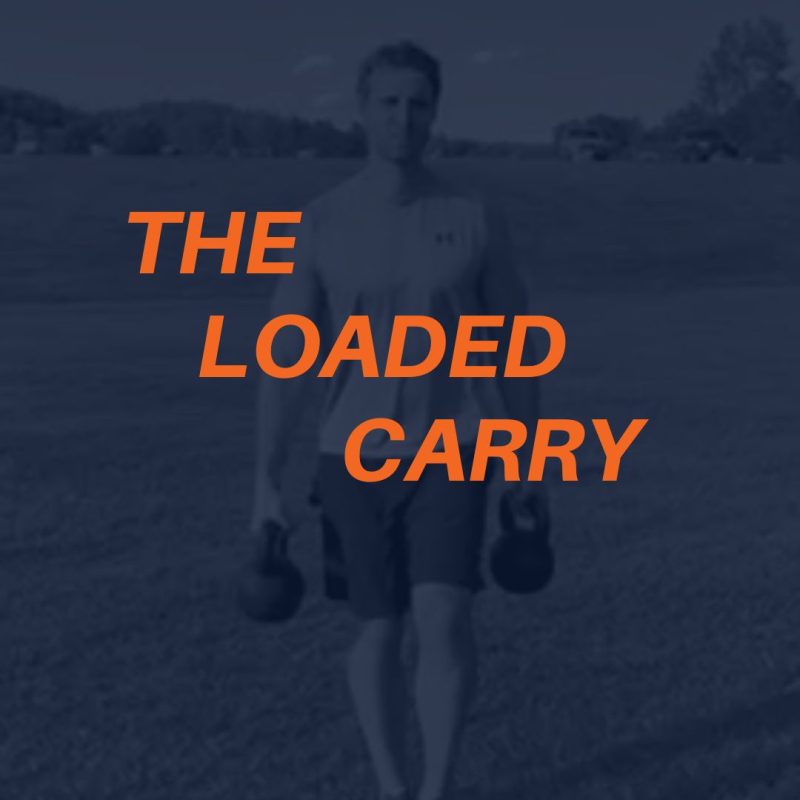
It’s no surprise that as we age we naturally lose strength. As we age we lose power, balance, and stability which are also compromised. We often hear the term “core training” but one of the most important exercises to stimulate core strength is likely not incorporated into regular workouts. Instead of losing strength, grip strength, power, balance, and stability amongst other things, teach your personal training clients to build core strength with the loaded carry.
What is a Loaded Carry?
The loaded carry is when you pick up weight in each hand (sometimes just one) and walk from point A to point B. This may sound rather simple, but with enough weight or long enough distance, it won’t feel that easy. When you carry grocery bags or luggage in suitcases, you are essentially doing a farmer’s walk. I personally take it a step further and program carries into most, if not all, of my workouts and every personal trainer should, too.
How to do a Loaded Carry?
1.) Stand hip-width apart with two kettlebells outside of your body. Hinge back and pick up two kettlebells (one in each hand).
2.) Stand tall, “proud” chest, and core engaged. Slowly walk without letting the weights touch your sides (this engages your lats and shoulder stabilizers).
3.) Keep your eyes forward while maintaining straight, stable alignment of the spine.
Benefits of the Loaded Carry
Improves Posture and Anatomical Positioning
The loaded carry forces us to retract and externally rotate the shoulder (to an extent) so that the weight doesn’t pull us forward. This helps to reverse the common position of an internally rotated shoulder. One cue I often tell my clients is to pull the shoulder blades back and down which pulls the scapula into a retracted position and the glenhumeral joint into alignment from an anterior position, thus opening up the pecs (that are often short and contracted) and the muscles of the shoulders. This activates the muscles that often reverse mobility and stability restrictions; the retraction and depression of the scapulae allow the shoulders to work in a safe position.
Increases Core Stability
Carrying weight forces your body to brace, which creates a rigid, stronger core. The stronger the core, the more powerful your limbs will be when performing heavy lifts, improving power development in your arms and legs.
Builds Muscle
Due to the high levels of muscular tension, farmers’ carries and sandbag carries result in upper back and trapezius hypertrophy. The carry works the entire body to gain strength and studies show that it increases salivary testosterone comparable to a high-volume hypertrophy program.
Increases grip strength
Loaded carries are a taxing way to work your grip. Studies show that a stronger grip correlates with lower mortality–the stronger the grip the longer you tend to live. Gaining a stronger grip translates to more muscle, lifting more weight, and a stronger body overall. One study found that in men between the ages of 45 to 68, “hand grip strength was highly predictive of functional limitations and disability 25 years later.” Another study found that at the age of 85, lower hand grip strength was associated with poorer functional, psychological, and social health.
Builds work capacity
Simply put, exercises like a loaded carry allow us to do more work in the gym. Work capacity can be defined as the total amount of work (i.e., sets and reps) that you’re able to not only perform, but also recover from adequately and adapt to positively. I could go as far as to say that if you simply carried objects consistently over time you would build endurance and become more athletic and adapt to better aerobic/anaerobic shape.
Self-limiting
Very few exercises are considered safe when adding more intensity without an increase of injury. All of my clients do at least some variation of a loaded carry because the benefits are very high and when they can’t do any more, they simply put the weight down. No one gets hurt especially when the basics of form are understood by the client.
Stronger Bones
The loaded carry puts the body in an optimal position to absorb muscular stress. This has a positive effect on your skeletal system by creating denser and stronger bones. For the young, this is hardly a concern but as we age we lost bone size and durability which can lead to osteopenia and osteoporosis.
Common Mistakes on Loaded Carries
This isn’t to say there aren’t ways to mess this up! Be certain your clients don’t make these mistakes:
- Over-arching the back—the spine should stay neutral, with abdominals and glutes engaged
- Forward head posture
- Moving too quickly (carries are not sprints!)
- Rounding the shoulders forward
Some Variations of the Loaded Carry
Get creative! Once your client gets comfortable in one iteration, challenge them with another:
Farmers Carry
Suitcase Carry
Single Arm Rack Carry
Double Rack Carry
Single Arm Overhead Carry
Double Overhead Carry
Goblet Carry
Set up like a goblet squat, and carry the weight with both hands at chest height.
Programming Considerations for Loaded Carries
As with any other type of resistance training exercise, there is an inverse relationship between load and repetitions, or in this case, distance traveled. The heavier or more intense, the less distance traveled for a set; the lighter or less intense, the greater the distance traveled. Also, when just starting out, gradually increase the load over time; there is value in mastery and getting used to the feel of the exercise. Here is a good rule of thumb, depending on if you are working on strength or muscular endurance:
Strength: 2-3 sets of 30 – 40 meters (about 100 feet)
Muscular Endurance: 1-2 sets 80-100 meters (about 200 feet)
Variety is the spice of life
Just as loaded carry variations have their own unique training benefits, so does the object that you are carrying. Kettlebells and dumbbells are often used but you can also substitute in sandbags, buckets with handles, barbells/trapbars–pretty much anything you can add load to! Always make sure to lift any object properly off the ground to avoid injury.
Carry On
Hopefully, if you weren’t already doing loaded carries, this article bore some influence. The loaded carry is safe and practical for everyone and is scalable to the individual. Think about what you will gain by carrying some weight. I can speak for myself and for the clients that I have trained that loaded carries do work. It is a simple exercise, you pick up a weight and carry but can be one of the most intense exercises when using challenging weights. Do the hard work and go carry something.
Learn more in our Functional Training Specialist as a part of our Continuing Education Course Series.

References
Rantanen T, Guralnik JM, Foley D, et al. Midlife Hand Grip Strength as a Predictor of Old Age Disability. JAMA. 1999;281(6):558–560. doi:10.1001/jama.281.6.558
Diana G. Taekema, Jacobijn Gussekloo, Andrea B. Maier, Rudi G. J. Westendorp, Anton J. M. de Craen, Handgrip strength as a predictor of functional, psychological and social health. A prospective population-based study among the oldest old, Age and Ageing, Volume 39, Issue 3, May 2010, Pages 331–337, https://doi.org/10.1093/ageing/afq022
Jason Colley, Loaded Carries For Improved Body Position And Health https://www.elitefts.com/education/loaded-carries-for-improved-body-position-and-health
Dorian Vermeir, Why You Should Consider Adding Kettlebell Carries To Your Training, https://www.strongfirst.com/consider-adding-kettlebell-carries-training
Karina Inkster, Lifetime Daily, www.lifetimedaily.com/hand-grip-exercises/





